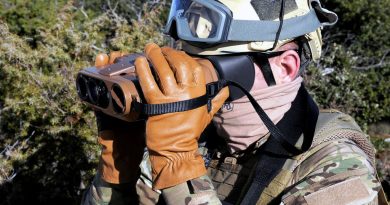Safran UAS, C-UAS and Loitering Munitions unveiled
At Eurosatory 2024 Safran Electronics & Defense unveiled a series of new systems, ranging from counter-UAS, to unmanned air systems, to loitering munitions, considerably widening its portfolio
More than one company produces offensive and defensive systems, often in the same domain. Safran Electronics & Defense is one of them, and at the Paris exhibition it unveiled a number of systems in the unmanned air domain, ranging from ISR unmanned systems, to loitering munitions, to counter-UAS.
Lanner, the MAME UAV aiming the French SDTL contract
To meet the requirements of the SDTL (Système de Drone Tactique Léger, light tactical drone system) program for the French armed forces, a medium altitude medium endurance UAS that will be delivered to Special Forces and French Army units, Safran Electronics & Defense teamed with Edge Autonomy. At Eurosatory the two companies unveiled the Lanner configuration of the Penguin C VTOL airframe.
Designed and produced by Edge Autonomy, this UAS features a central fuselage with the internal combustion engine at the rear, powering a two-blade pushing propeller. Although no details were provided, it is quite probable that the Lanner leverages the latest propulsion improvements with the adoption of a new high-reliability 28cc electronic fuel injection engine complemented by a new fuel pump system that ensures the system to operate at higher temperatures. The high wing is fitted with two pods, right and left, each carrying two rotors powered by electric motors, that give the system its vertical takeoff and landing capacity.
The key feature of the Lanner is its dual-load capacity, the gimballed electro-optical day/night payload located at the front under the fuselage being complemented by a second payload, which can be for example an electronic passive or active system, a radar, or even ammunition. This considerably increases the system operational flexibility, both over land or at sea.
In the Lanner configuration the Penguin will see its MTOW increasing from 41 to 50 kg, wingspan stepping up from 4.12 to 5 metres, endurance being marginally reduced from 12 to 10 hours, operational ceiling being 4,000 metres. Line-of-sight communications range is 100 km, with rugged and encrypted links, but it should be increased using other data-link systems.
The Lanner has a very small logistic footprint, as it can be easily transported in two cases that fit into a pick-up truck, while its VTOL property allows to operate it without the need of a runway or a catapult. The UAS can be assembled in less than 15 minutes by a two-man crew, according to companies.
It is compliant with NATO C4I standards and is fitted with a GNSS-denied navigation system, no details being provided, but Safran capacity in this field is well known. The Lanner is capable of autonomous target search, detection and identification thanks to the Safran-developed and AI-based Advanced Cognitive Engine, ACE in short.
Numerous types of systems can fit within the 10 kg payload limit. The EO typical payload includes high definition day and infrared cameras with continuous, a laser ranger finder and a laser designator. EW payloads can include an international mobile subscriber identity-catcher, and/or VHF/UHF/ASTCOM interceptors. Multimode SAR/MTI radars can be fitted for surveillance and search and rescue missions, while communication relays would permit to increase communication range of airborne or ground-based comms systems.
The Lanner configuration of the Penguin C VTOL drone is considered at TRL 7, the airframe continuing its flight test programme. Its serial production should start within year end, while in 2025 Safran and Edge Autonomy plan the integration of new payloads.
Looking at future applications the two companies are considering other payloads to further increase the Lanner operational capacity, systems such as LIDAR (Light Detection and Ranging), AIS (Automatic Identification System) for maritime applications, CBRN (Chemical, Biological, Radiological And Nuclear), being high on the list. A weaponised version with the Lanner carrying loitering munitions is also being considered.
Warbler, the Safran loitering munition
These will not be the one unveiled by Safran at Eurosatory, as the Warbler mass at launch is around 20 kg. Designed by Safran, the Warbler is a long-range loitering munition that can strike at up to 50 km relocatable high-value targets. Exploiting the company ACE it can autonomously search, detect and identify the target, while keeping the man-in-the-loop who will give the green light for the attack. The airframe is pretty simple, with a 1.2 metres long fuselage that carries two sets of wings, two forward ones that are folded backwards in the launch canister, and two rear ones that are folded forward, the Warbler having a wingspan of over 2 metres. Propulsion is provided by an electric motor located at the rear driving a two-blade pushing propeller, the system being capable to reach the kill box in a 30 minutes flight, navigation being ensured by an anti-spoofing and –jamming system, and then loiter over the area of interest for 60 more minutes, the Warbler being able to conduct swarm operations to saturate enemy defence systems. It carries a 3 kg anti-armour warhead, no more details being provided.
It can be launched from a canister fitted on a ground vehicle, a helicopter, a ship or a tactical UAV, and at Eurosatory a Safran Patroller UAV was shown with three Warblers under each wing, the Patroller payload being 210 kg. SafranElectronics & Defense is planning the first flight of the Warbler in 6 months time.
Countering unmanned air threats, Safran Skyjacker
Stepping on the other side of the game, Safran exhibited at Eurosatory a Counter-UAS system dubbed Skyjacker, a typical dual-use system that can be deployed for defending military and naval bases, as well as convoys, but can also be used to protect critical infrastructures and special events. It can spoof or jam signals once it has detected and identified their source, denying their GNSS-based positioning system. According to Safran, the jamming cone angle is 60°, which means that the Skyjacker is effective against multiple threats.
The system is mostly aimed against low-cost/low-tech systems, aiming at avoiding the use of kinetic effectors, reserving those for higher tier threats.
According to the company the Skyjacker can be effective over 10 km on land, while in the maritime version its range is of around 50 km. The Skyjacker is deployed according to the area to be protected and to the envisaged threat. The spoofing signal is activated following the detection and identification by a radar or an electro-optic system, and the incoming threat trajectory is shifted depending on the spoofing strategy, artificial intelligence being key in training the system on various detection and attack strategies.
The Skyjacker can be installed either in fixed positions or on mobile platforms, the one exhibited in Paris being integrated onto a Land Rover Defender.
The Skyjacker is being deployed by undisclosed official entities to protect Paris Olympic Games.
Photos by Safran and P. Valpolini










